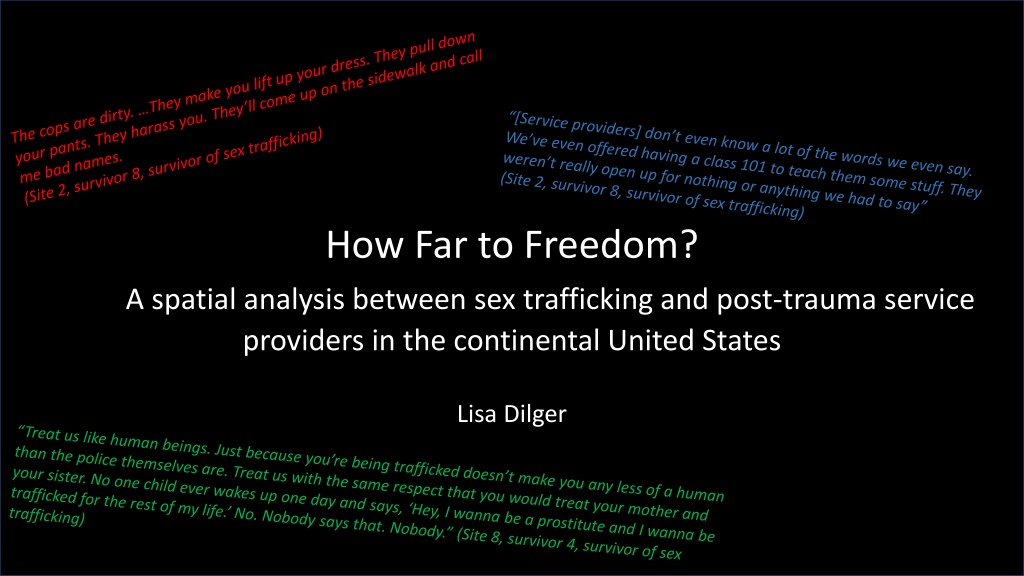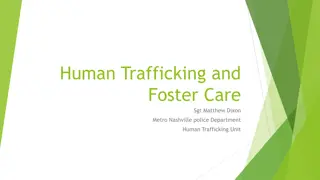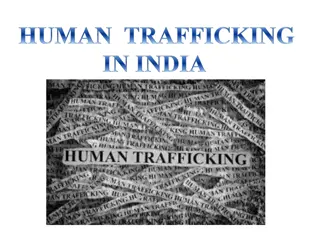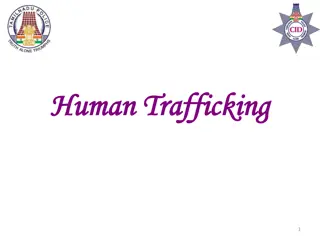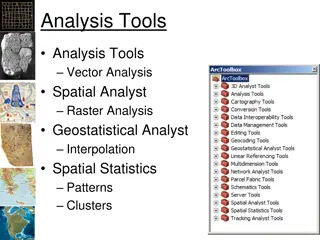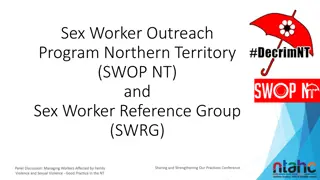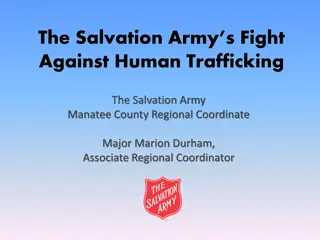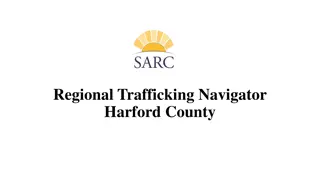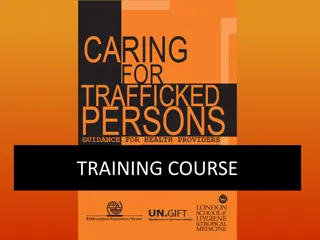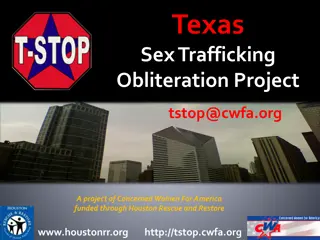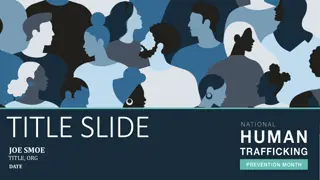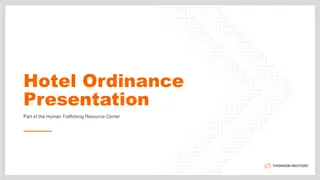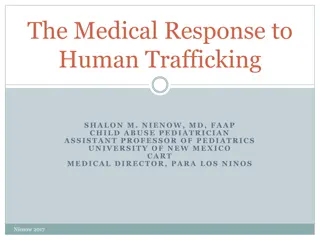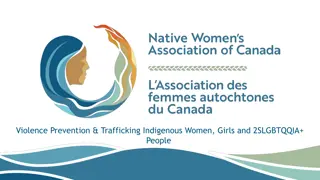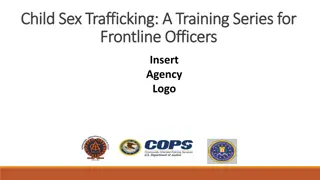Spatial Analysis of Sex Trafficking and Post-Trauma Service Providers in the United States
This study delves into the spatial relationship between sex trafficking and post-trauma service providers in the continental United States. It highlights concerning statistics on human trafficking, survivors' needs, and the critical role of non-profit organizations in supporting survivors. The research aims to identify hotspots of human trafficking through geospatial analysis and proposes a methodology involving police open data and geospatial tools.
Uploaded on Oct 10, 2024 | 0 Views
Download Presentation

Please find below an Image/Link to download the presentation.
The content on the website is provided AS IS for your information and personal use only. It may not be sold, licensed, or shared on other websites without obtaining consent from the author. Download presentation by click this link. If you encounter any issues during the download, it is possible that the publisher has removed the file from their server.
E N D
Presentation Transcript
How Far to Freedom? A spatial analysis between sex trafficking and post-trauma service providers in the continental United States Lisa Dilger
Trafficking global map Estimated 4,000,000 adult and 1,000,000 children globally in 2016 (UN Internal Labour Organization, 2019) Estimated global profit: $99,000,000,000 (Internal Labour Organization, 2014) Map source: Freedom Collaborative
Trafficking US map 2019: 48,326 individual trafficking-related contacts were made to the National Human Trafficking Hotline (Polarisproject.org, 2020) Currently Polaris Project has 388 registered human trafficking specific resources in their referral guide Map source: Polaris Project Map source: Freedom Collaborative
Survivors often without financial freedom, removed or isolated from family and/or social network, have a criminal record, struggle to combat the force, fraud, or coercion element Survivors often rely on non-profit organizations to meet their immediate safety and emergency needs The resources often requested: Temporary housing/emergency shelter Extraction Immediate medical assistance Immigration assistance Family reunification Financial assistance. Ability to vacate their criminal records Mental health resources Long-term rehabilitation Background US Federal Definition: Human trafficking involves the use of force, fraud, or coercion to obtain some type of labor or commercial sex act The cops are dirty. They make you lift up your dress. They pull down your pants. They harass you. They ll come up on the sidewalk and call me bad names. (Site 2, survivor 8, survivor of sex trafficking)
Sex Trafficking Social Spatiality 19,300 934,000 peer reviewed studies 17,400 published since 2019 94,300 peer reviewed studies 14,500 published since 2019 12,100 73,100 16,400 409,000 peer reviewed studies 17,200 published since 2019 Post-Trauma Service Providers
When is shelter safe? Goals & Objectives Ways forward? How far does one travel to be safe? Map source: Polaris Project
Proposed Methodology 1 2 3 4 Use police Open Data for human trafficking point data Identify statistical hotspot of human trafficking kernel density Use geospatial tools to identify the known average, minimum, and maximum distances between statistical hotspots and service providers Utilize survivors and published surveys to put the distance into context Not complete data set Illicit crimes always under reported Survivors often charged as criminal
Map source: Polaris Project Map source: Polaris Project Polaris Data
Along the coasts of the US, there are likely a large human trafficking hot spots with multiple service providers The minimum distance traveled is likely within 5 miles in this area In the middle and southern US will likely have the largest distances between hot spots and service providers. Anticipated Results
Possible Presentation Venues Slave Free Today: Journal of Modern Slavery Anti-Trafficking Review
Bales, K., Ph.D, & Lize, S., Ph.D. (n.d.). Trafficking in Persons in the United States (United States, Department of Justice, NCJRS). Cockbain, E., Bowers, K. Human trafficking for sex, labour and domestic servitude: how do key trafficking types compare and what are their predictors?. Crime Law Soc Change 72, 9 34 (2019). https://doi.org/10.1007/s10611-019-09836-7 Cockbain, E., & Wallis, A. (2019, April 17). The Social, Spatial and Temporal Systems Behind Human Trafficking. Retrieved September 18, 2020, from https://delta87.org/2019/04/social-spatial-temporal-systems-human-trafficking/ Farrell, A., Ph.D, Dank, M., P, Kafafian, M., Lockwood, S., Pfeffer, R., Hughes, A., & Vincent, K., Ph. (2019). Capturing Human Trafficking Victimization Through Crime Reporting (Rep. No. 252520). NCJRS. Freedom Collaborative. Mapping Victim Journeys Around the World. 2020. Retrieved October 10, 2020 from https://freedomcollaborative.org/victim-journey-data/ Gozdziak, E., Ph.D, & Lowell, L. (2016). After Rescue: Evaluation of Strategies to Stabilize and Integrate Adult Survivors of Human Trafficking to the United States (Rep. No. 249672). NCJRS. Holzer, J. W. (2010). A spatial analysis of human trafficking in Greater Los Angeles (Doctoral dissertation, Thesis / Dissertation ETD, 2010) (pp. 1-24). Ann Arbor, MI: ProQuest. References Kelly, C. (2019, July 29). 13 sex trafficking statistics that explain the enormity of the global sex trade Retrieved October 10, 2020 from https://www.usatoday.com/story/news/investigations/2019/07/29/12-trafficking-statistics-enormity-global-sex- trade/1755192001/ Love, H., Hussemann, J., Yu, L., McCoy, E., & Owens, C. (2018). Justice in Their Own Words: Perceptions and Experiences of (In)Justice among Human Trafficking Survivors. Urban Institute. McCann, M. (2018). Human Trafficking: An Overview of Services and Funding for Survivors. National Conference of State Legislatures. Mletzko, D., Summers, L., & Arnio, A. N. (2018). Spatial patterns of urban sex trafficking. Journal of Criminal Justice,58, 87-96. Polaris Project. (2020) Retrieved October 1, 2020, from https://humantraffickinghotline.org/training-resources/referral-directory Rothman, E., Bair-Merritt, M., & Farrell, A. (2019). Evaluation of a Service Provision Program for Victims of Sex Trafficking. Sarrica, F. The Use of Human Trafficking Detection Data for Modelling Static and Dynamic Determinants of Human Trafficking Flows. Eur J Crim Policy Res (2020). https://doi.org/10.1007/s10610-020-09460-5 Weiner, N. A., & Hala, N. (2008, October). Measuring Human Trafficking Lessons from New York City. (United States, Department of Justice). Retrieved September 9, 2020, from https://www.ncjrs.gov/pdffiles1/nij/grants/224391.pdf
